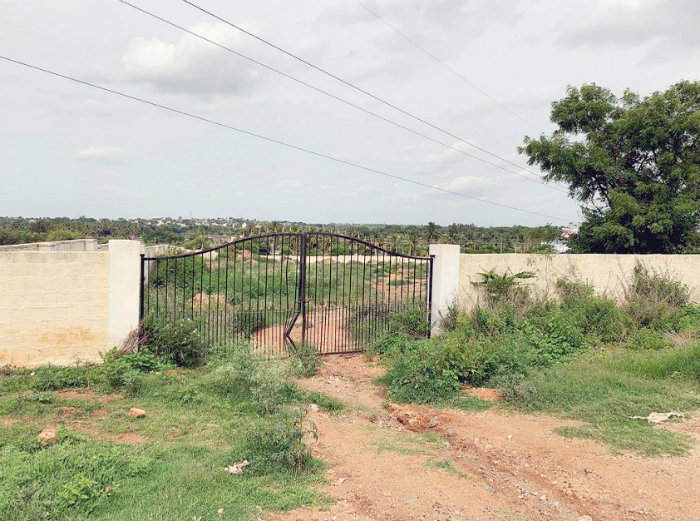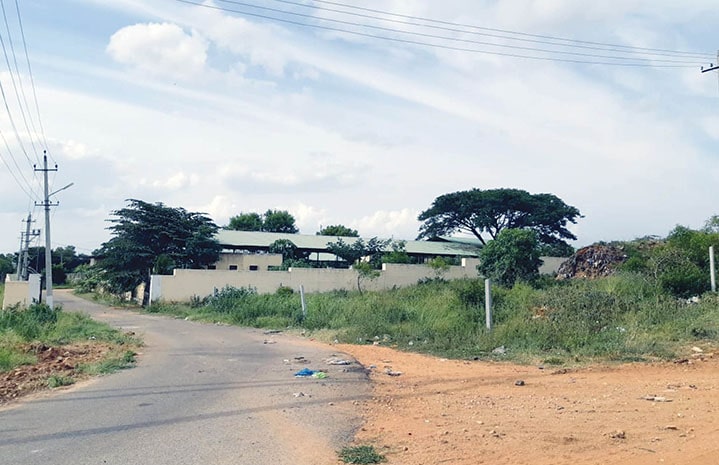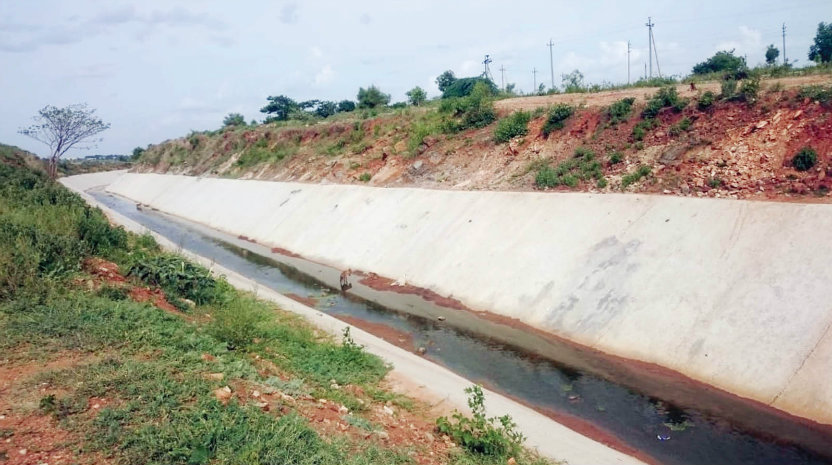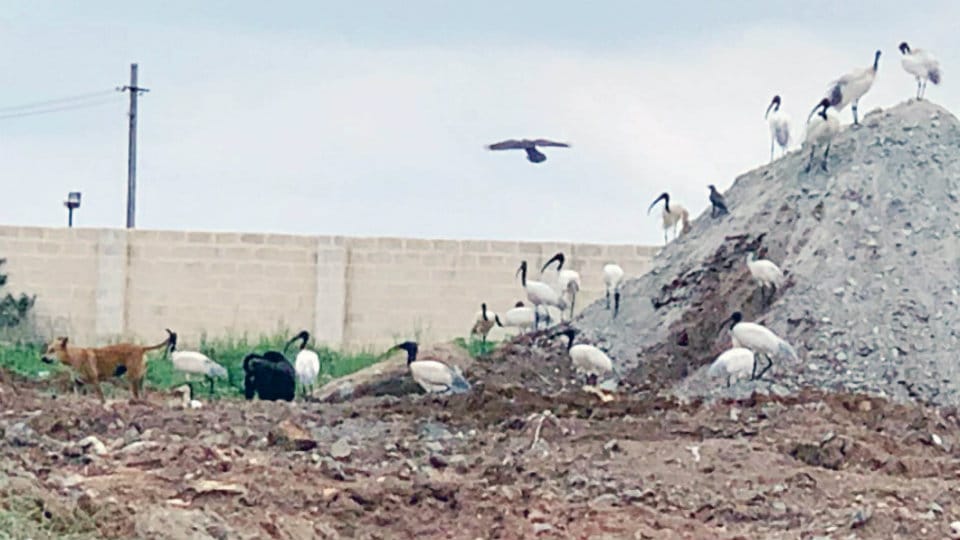If Saadat Hasan Manto, writer, playwright and author born in Ludhiana during the British Raj became famous with his Urdu short story “Boo” that means “Smell”, a quiet locality in Mysuru is becoming famous or rather infamous or call it notorious for its “Smell” — a horrible meat waste stench.
The smell is due to the unscientific burial of meat waste that is generated in city. The carcasses are buried or discarded at the place resulting in unbearable smell that permeates the entire locality. The putrefaction smell is so bad that residents have to move around and be within their houses with their noses closed with perfumed handkerchiefs.
The area is Old Kesare (Kamanakerehundi) within the limits of Mysuru Corporation (MCC) where slaughtered animal and fish waste is brought from various parts of the city and buried. The city has more than 500 chicken, mutton and fish stalls spread across areas and together they generate more than 10 tonnes of waste every day and even a gram of it is not processed. All the animal waste is brought here and discarded.
Slaughter house waste consists of the portion of a slaughtered animal that cannot be sold as meat or used in meat-products. Such waste includes bones, tendons, skin, and contents of the gastro-intestinal tract, blood and internal organs.
The waste comes in eight trucks (six owned by MCC and two trucks contracted) from around city on a daily basis. The area is owned and operated by the MCC and is next to a Zero Waste Management Plant. There is no signboard to indicate that it is owned by the MCC and the place is out of bounds.
The MCC has been so far claiming that it scientifically disposes of the animal waste by digging deep pits of 15 to 20 feet and then buries the waste. But on the contrary, the meat waste is discarded in the open leading to bad smell and giving an open invitation to dogs to feed on them.
Open invitation for dogs, vultures
Dogs, vultures, rats, rodents, cranes and crows come in large numbers to feed on the animal remains and they sometimes birds-drop animal skin and parts on top of houses and buildings. The gate surrounding the bone extraction unit has been ingeniously twisted and bent to facilitate the entry of stray dogs. Some dogs even jump the parapet wall to eat the rotting flesh. The entire place is surrounded by a compound wall.
The waste plant unit is located in a residential area surrounded by Karnataka Housing Board (KHB) Layout, Poornaprajna Layout and there are many schools of international repute, engineering colleges and missionary centres in the vicinity. Also, people have built houses and there are more than 10,000 people living in the surroundings. The area also has a lake (Kamanakerehundi Lake) and the Varuna Canal is just a few metres away from the meat waste plant.

A hellish experience
Residents of the locality say that living amidst smell is a hellish experience. Speaking to Star of Mysore, Mahesh Kumar, a resident of the area said that the area was once surrounded by green fields, farm lands, and a lake as well as rivulets.
“Now we are cursing ourselves daily as the smell from the waste unit is dominating our lives. Slaughtered animals are brought from various places and the remains are either discarded or buried deep in the soil. These people use excavators and earth movers to dig deep into the soil and the animal remains are buried. Due to this, the groundwater gets polluted. More than anything, the stench is unbearable,” he said.
Unbearable stench
“Life has become miserable here and during festivals where meat is consumed in large quantities, the stench is unbearable as a large quantity of waste is generated. The MCC brings the waste in trucks and does not immediately bury them. Instead the meat is dumped to rot and the waste is buried after several hours as it takes time to excavate the earth. This is the root cause for the stench,” said Gurumallesh, another resident of the area and who is a lecturer at a nearby college.
“I have to pass the waste unit every day and I cover my nose with a scented handkerchief. Even after I come home, the stench is ubiquitous,” he added.

Irreparable environmental damage
The practice adopted at the meat waste disposal unit is in direct violation of all norms of the civil society and international standard practices that specifies rules to dispose of the dead animals. “They are poisoning the ground water and causing irreparable damage to the environment. Already we are facing rashes on our skin and we suspect that the water is already polluted. The unit is a perfect source for water-borne diseases,” said Srinidhi, another resident of the area who works in a factory.
“There are more than 100 dogs in the vicinity and once they eat the meat, they roll inside the Varuna Canal water. And the same water is consumed by people downstream. These dogs are habituated to consume raw meat. What if they attack children in the locality,” asked Vidya Sadashiva who teaches at a nearby Kindergarten.
The absence of a proper mechanism for meat waste disposal comes as no surprise in a city where garbage management remains a mammoth challenge. The nights are particularly when breathing itself becomes an obnoxious burden. “We can close our windows but the sweltering summer doesn’t even allow that and we have to bear the stench,” she added.

Need of a rendering unit
“Instead of just dumping the waste in land polluting the entire atmosphere, the MCC must come up with novel ideas to scientifically dispose of the waste like it is practiced in Western countries like biogas production, composting, rendering, pet foods, animal feeds etc. from different slaughter house by-products,” said Suhas a chemical engineering student.
“Proper treatment and efficient utilisation of slaughter house waste will lower the chances of environmental pollution manifold and will lead to production of many valuable products, useful for animal feed, industries and agriculture,” he opined.
Disposal as per norms, justifies MCC
Reacting on the complaints of the residents, MCC has stated that it disposes of the waste in a scientific manner and as per procedure. As per the rules of Municipal Solid Waste Management, slaughter house waste should be disposed by adopting various processes like rendering, controlled incineration, burial or composting.
“Animal waste from slaughter houses is not allowed to be mixed with the Municipal waste. It should be carried separately. We are following standard procedures and many City Corporations have adopted our model as it is scientific,” said Dr. S.C. Suresh, Assistant Director, Veterinary Department, Mysuru City Corporation.
Regarding groundwater pollution, he said that only if the waste is buried in pits that are more than 20 feet, the groundwater gets polluted. “We restrict the digging up to 15 feet,” he claimed.
An Animal Waste Processing Plant or a rendering plant worth Rs. 8 crore is in the pipeline and will be established in the coming months after obtaining clearance from the State Government. “We have got a proposal from a private person who has a 50-tonne daily meat waste biogas generating plant in Nanjangud and he has a daily requirement of meat waste. Mysuru city generates 10 tonnes of meat waste,” he said.
“The private person has even agreed to transport the waste daily from Mysuru to Nanjangud. We are examining the proposal and feasibility. Once the proposal is passed in the MCC Council and is effectively implemented, the meat waste plant at Old Kesare will be closed down,” he said.








Recent Comments